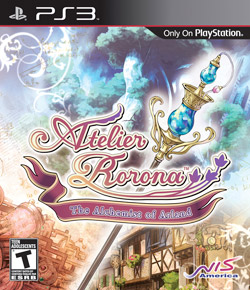Atelier Rorona: The Alchemist of Arland
| Atelier Rorona: The Alchemist of Arland | |
|---|---|
 |
|
| Developer(s) | Gust Co. Ltd. |
| Publisher(s) |
|
| Director(s) | Yoshito Okamura |
| Artist(s) | Mel Kishida |
| Composer(s) | Ken Nakagawa |
| Series | Atelier |
| Platform(s) | PlayStation 3, PlayStation Vita, Nintendo 3DS |
| Release date(s) | |
| Genre(s) | Role-playing |
| Mode(s) | Single-player |
| Aggregate scores | |
|---|---|
| Aggregator | Score |
| GameRankings | 70.48% |
| Metacritic | 65/100 |
| Review scores | |
| Publication | Score |
| Famitsu | 30/40 |
| GameSpot | 6.0/10 |
| IGN | 5.0/10 |
Atelier Rorona: The Alchemist of Arland (ロロナのアトリエ ~アーランドの錬金術師~ Rorona no Atorie ~Aarando no Renkinjutsushi~?) is a Japanese role-playing video game developed by Gust Co. Ltd.. It was first released for PlayStation 3 on June 25, 2009, in Japan and re-released as a Japanese Best Version on September 23, 2010, due to its sales figures. The North American release followed on September 28, 2010, along with a European release on October 22, 2010 and an Australia release on October 28, 2010.
Atelier Rorona is the eleventh installment in the Atelier series, and it continues the series' emphasis on item synthesis. The game is the first title in the series to be developed for PlayStation 3, and it is also the first to utilize 3D models as opposed to the 2D sprites in earlier titles. A sequel titled Atelier Totori: The Adventurer of Arland, which takes place five years after the end of Atelier Rorona, was released in Japan on June 24, 2010.
Gust released a remake of Atelier Rorona titled Atelier Rorona Plus: The Alchemist of Arland for PlayStation 3 and PlayStation Vita on November 21, 2013 in Japan, and on June 2014 in the West. In Australia, it received a rating of "R18+" for "Sexual Violence".
Atelier Rorona has four main modes of gameplay: a field map, a battle screen, an alchemy system, and a visual novel system. Navigation occurs via two static map illustrations, which depicts the Arland town and its surrounding area in a scaled down view. Field map areas such as the town and forests are depicted as realistically rendered environments, in which the player can converse with locals, gather items, or encounter enemies. Enemies on field maps are openly visible to the players, and players can either engage or avoid the encounter. Contact with the enemies initiates a separate battle screen.
...
Wikipedia
